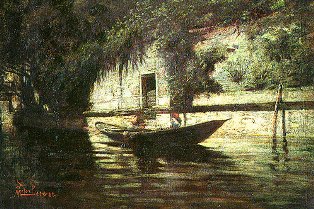
WTI Magazine #41 2014 July, 30
Author : Enrico De Iulis Translation by:
Mario de Maria was born in Bologna in 1852 from a family of noble origins and already at least by three generations inserted in the Italian cultural and artistic climate. Given also the excellent disposable income, his artistic training was affected by the many journeys to Europe and through Italy in order to study with Luigi Serra and other artists of his city.
Starting from a strong passion for the painting of the past, that he had been able to see up close in his family collection, De Maria builds a personal world by bringing to the canvas, adding to the mystical aspects of the great exponents of Italian of the past the visions of the new school of painting "en plein air" of Barbizon, and the Nordic taste well studied in Vienna, Austria.
In 1882, called from Serra, he moves to Rome and settles in an attic in Via Margutta, frequenting the Roman life and permanently acquiring a deep sense of nature and its sensitivity. It is in these years that Gabriele D'Annunzio will give him the nickname "the painter of the moons", for his penchant to paint landscapes and nocturnal atmospheres. This visionary realism, obtained by combining all the components mentioned so far, becomes a key to a very interesting and personal view of his painting.
After some disagreement with a few members of the intellectual Roman circle, de Maria moves permanently to Venice in 1892, continuing the production in its unique style and keeping close contact with D'Annunzio. He therefore plays an active part in the establishment of the first Biennale of Art in Venice, immersing himself in the cultural Venetian life already attentive to the double value of future and present in art with the biennale, and to the past thanks to the first major work to raise awareness for the protection of the historical buildings of the city.
From this moment his art begins to be appreciated and recognized and his creative career continues: Ugo Ojetti, journalist, columnist and avid art collector, buys some of his works and years later will comment: "His most macabre works then would satisfy him as if they were a party".
The night, the almost intimate and fantastic suspended air of northern Europe, but filtered by the Italian and especially Venetian landscape, small figures like ghosts in a dream vision that sparkle thanks to the wise chiaroscuro obtained with precious materials, decaying constructions suspended in the lagoon: these are always recognizable stylistic elements in the style of de Maria.
In 1905, after the death of his daughter Silvia, his dark vision introjects and makes him falter enough to be hospitalized in a psychiatric clinic in Berne, Switzerland.
Back to Venice, the artist embodies everything that life has taught him in the new home building in memory of his daughter: "The three oci" at the Giudecca. The house is particularly interesting, still beautiful and instantly recognizable in a glance from Zattere (where de Maria had his studio) looking towards the Giudecca. A house that can be considered a rare example of modern and personal language, combined with the architectural fabric of Venice.
From 1895 until 1922 he will participate with no interruptions at the Biennale d'Arte, rehashing old paintings from which he will extrapolate new visions, practicing well the new art of photography and even mildly approaching the futurist avant-garde.
He will die in 1924: a major artist, currently little known, but rare in his testimony of central Europe style.



